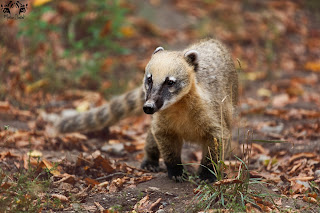
The ring-tailed coati is a mammal in the Carnivore order. Because it is only found in South America, it is also known as the South-American coati. The ring-tailed coati is found in the tropical and subtropical regions of the Andes, Colombia, the Guianas, Uruguay, and Argentina. The ring-tailed coati is found in dense forests and wet jungles. This animal is classified as least concern, which means it is not on the endangered species list.
The ring-tailed coati is a medium-sized creature. It can weigh between 4.4 and 16 pounds and measure up to 44 inches in length. The tail is half the length of the body.
The name “ring-tailed coati” refers to the black rings that cover the coati’s tail. The rest of the body is covered in thick, tan fur.
The ring-tailed coati is a diurnal (daytime) animal.
Ring-tailed coatis spend part of their lives on the ground and part of their lives in trees. They are looking for food in the trees as well as on the ground. They are seeking protection from predators by hiding high in the trees.
The ankles of the ring-tailed coati are extremely elastic, allowing it to move quickly from the ground to the tops of the trees. They can run from the tree to the ground by putting their heads before their legs. Flexible ankles are a specific adaptation to tree life.
The ring-tailed coati is a carnivore (eats both plants and animals). It feeds on small mammals, reptiles, and invertebrates, as well as eggs, nuts, seeds, and fruit.
Ring-tailed coatis have a keen sense of smell, which aids them in locating food.
Females live in small groups of 15 to 30 animals. The term “band” refers to a group of ring-tailed coatis. Males are solitary beings. They only congregate with females during mating season.
The sound is used by the members of the group to communicate. The type of sound they want to send is determined by the “message” they want to send. Whining sounds are used for regular communication. Animals make loud woofs and clicks when they are in danger.
To protect themselves from predators, ring-tailed coatis spend the night in trees.
Jaguars, jaguarundis, pumas, foxes, dogs, birds of prey, snakes, crocodiles, and humans are the main predators of ring-tailed coatis.
The availability of fruit, which is used as a primary source of energy, is closely related to the mating season. It occurs at the start of the rainy season.
In contrast to other animals, the female will mate with more than one male.
Pregnancy lasts three months and results in two to seven babies. Female departs from the group to construct a nest in a tree, where she will care for the babies. Young ring-tailed coatis join the band with their mother at the age of 6 weeks.
Ring-tailed coatis can live in the wild for up to 7 years and in captivity for up to 15 years.









